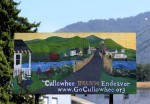
Creating the 8-by-16-foot wide hand-painted murals that replaced faded billboards on Old Cullowhee Road was exhausting—physically and mentally—as well as inspiring, said one of the five students who helped design and paint them.
“I share the Cullowhee Revitalization Endeavor’s vision, and this sign is kind of symbolic of what CuRvE is trying to do,” said Joseph Hader, a senior fine arts major with a concentration in graphic design from Cary. “We took an old, peeling sign and replaced it with something new that helps define the area.”
One side depicts a student’s idea of what a beautified Cullowhee could look like. The other side says “Welcome to Cullowhee: Valley of the Lilies.” The project was among 31 completed by students in a summer mural class taught by Erin Tapley, associate professor of art education. Their clients ranged from the American Red Cross in Asheville to Rickman General Store in Cowee Valley.
“The class wedded the idea of purposeful design and creativity,” said Tapley. “Most students had previous training in art or painting in which their assignments were probably based in technical mastery and the development of their individual style. This course required working together, and selecting and executing a design based on the expressed needs of the nonprofit agency.”
Community beautification has been a focus for CuRvE, a nonprofit organization committed to revitalizing Cullowhee along the Tuckaseigee River and Old Cullowhee Road. When the opportunity arose to request a student-created mural, Chris Blake, a CuRvE co-chair and assistant professor of English, said members immediately thought of an old billboard in the area.
Arnold Ashe with Cullowhee Cafe, which has supported CuRvE, and his family offered to let the signs be refurbished in a way that would represent the community. Then in May, Seth Bach, a local graphic designer, met with Blake at Cullowhee Cafe to sketch some initial mural design ideas, and Bach incorporated one theory that the word Cullowhee comes from Cherokee language identifying the area as a place of lilies. In addition, Blake’s neighbor, Etheree Chancellor, loaned Blake a book with a picture of the “Cullowhee lily” that she said used to grow plentifully in the valley’s wetland areas.
Blake presented the concept to Tapley’s class, and five students—Hader; Kristina Finsterwalder, a senior art education major from Waynesville; Orlando Anderson, a sophomore art major from Greensboro; Katherine Monjure, a junior art education major from Kings Mountain; and Billy Love, a master’s degree student in art education from Columbia, S.C.—took part. The project was very involved, said Hader. For the side he designed – the side with the lilies – Hader considered details from the shades of color to the variety of lily. For the background, he proposed a shade of cream that would hint of the natural green of the trees in the community and a lavender that would hint of the purple of neighboring WCU. Hader worked with Blake to finalize the design, at one point using what he had learned in a typography class taught by Jon Jicha, professor of graphic design, to tweak the kerning, or the relationship between the letters.
Hader also found a photo of the kind of flower often considered the Cullowhee lily—the atamasco lily—and requested permission to use it from the photographer, David McAdoo of Kernersville. McAdoo, who enjoys photographing native orchids, carnivorous plants and wildflowers, spotted the flower while driving back roads near Savannah, Ga. “It is amazing what you can see when you go ‘car hiking,'” said McAdoo.
To prepare the boards for the mural, students used wood filler to create a smooth surface and installed them inside. The design was printed on a transparency, and then projected onto the boards. Students traced the design, mixed the colors and painted. They practiced techniques to create textured looks, such as the method used on the rocks, said Hader. “I had never done anything to that scale before,” said Hader. “It’s a test of endurance.”
Within five weeks, the Cullowhee mural was complete. “Although the revitalized Cullowhee of 10 years from now may look very different from what the students painted, we hope that the quaint, artsy, natural beauty expressed in the mural will always remain,” said Blake.
The next challenge was to find a way to remove the old signs and install the new ones. “Although they look small from the road, they are actually very large,” said Blake. The sign went up Aug. 17, thanks to help from Cullowhee residents such as Steven Burch and support either on-site or behind-the-scenes from WCU’s Facilities Management staff, including Roger Turk, Randy Fox, Brandon Green, John Freeman, L.G. Painter, Keith Dills, Travis Taylor, Terry Watson, Bo Aiken, Dale Mathis and R.B. Danner.
So far, the signs have been well received, said Norman West, who owns Cullowhee Real Estate. “Everybody loves them down here,” said West. “They are very handsome signs.”
Such mural projects are a good fit for revitalization efforts such as CuRvE’s, said Love, who had worked on similar projects in the past. Murals can not only make an area more attractive and highlight the community’s strengths but also, on their own, attract visitors. “They often become a destination in themselves,” he said.






